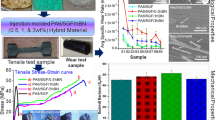Abstract
Five epoxy resins of different chemistry and functionality were cured with DDS (4,4′-diaminodiphenyl sulfone) using 2, 8 and 14 h curecycles. Both Differential Scanning Calorimetry (DSC) and Thermomechanical Analysis (TMA) were used to characterize reaction behavior and cured properties of the resin systems. In addition, static mechanical tests and density measurements were integrated with the thermal characterization methods to correlate resin properties with process time. Flexural three-point bending experiments showed that the resins tended to have higher yield stress and toughness values at extended cure times. The improved mechanical properties could be attributed to the full development of the epoxy molecular structure, in the form of cross-linked networks and molecular rearrangement. These results suggest that extended cure times or high temperature post-curing may be required to obtain the resin's ultimate mechanical properties for high performance composites.
Similar content being viewed by others
References
J. C. Seferis and L. Nicolais, The Role of the Polymeric Matrix in the Processing and Structural Properties of Composite Materials, Plenum Press, New York 1983.
P. K. Mallick, Fiber-Reinforced Composites: Materials, Manufacturing, and Design, second ed., Marcel Dekker, Inc., New York 1993.
H. S. Chu and J. C. Seferis, The Role of the Polymeric Matrix in the Processing and Structure Properties of Composite Materials, J. C. Seferis and L. Nicolais (Ed), Plenum Press, New York 1983, pp. 53.
R. B. Prime, Thermal Characterization of Polymeric Materials, E. A. Turi, Ed., Academic Press, New York 1981.
G. Wisanrakkit and J. K. Gillham, J. Coat. Tech. 62 (1990) 35.
C. A. May, Epoxy Resins, Chemistry and Technology, second ed., Marcel Dekker, Inc., New York and Basel 1988.
S.-B. Shim, K. Ahn and J. C. Seferis, Proc. 6th Tech. Conf. Am. Soc. Compos., 6 (1991) 1137.
Shell Chemical Company, Technical Bulletins: SC:613–87 (1987), SC:875–87 (1987), SC:235–91.828 (1991), SC: 1376–92 (1992), and SC:1357–93 (1993).
Ciba-Geigy Plastics Department, Product Data, Hardener HT 976 (1988).
A. Filippov, Shell Development Co., Personnel Communication, (1993).
S.-B. Shim, J. C. Seferis and L. E. Gerlowski, Sci. & Eng. Compos. Mat., In Press (1994).
J. P. Bell, J. Polym. Sci., A-2, 8 (1970) 417.
C. Jordan, J. Galy and J.-P. Pascault, J. Adv. Polym. Sci., 46 (5) (1992) 859.
Author information
Authors and Affiliations
Additional information
The authors would like to thank Dr. Andri Filippov of Shell Development Company for his interest in this work. Financial assistance and material support for this research were provided by Shell Development Company while instrument support was provided by TA Instruments through project support to the Polymeric Composites Laboratory of the University of Washington.
Rights and permissions
About this article
Cite this article
Chinn, D., Shim, S.B. & Seferis, J.C. Thermal and mechanical characterization of high performance epoxy systems with extended cure times. Journal of Thermal Analysis 46, 1511–1525 (1996). https://doi.org/10.1007/BF01980758
Received:
Revised:
Issue Date:
DOI: https://doi.org/10.1007/BF01980758




